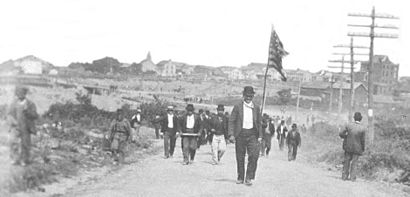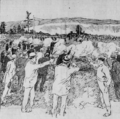Lattimer massacre facts for kids
Quick facts for kids Lattimer massacre |
|||
|---|---|---|---|
 |
|||
| Date | September 10, 1897 | ||
| Location |
Lattimer, Pennsylvania, U.S.
40°59′41″N 75°57′38″W / 40.9948°N 75.9606°W |
||
| Goals | Wage increase | ||
| Methods | Strikes, protest, demonstrations | ||
| Parties to the civil conflict | |||
|
|||
| Lead figures | |||
|
|||
| Number | |||
|
|||
| Casualties and arrests | |||
|
|||
The Lattimer massacre was a terrible event where at least 19 unarmed striking immigrant miners were killed. It happened at the Lattimer mine near Hazleton, Pennsylvania, on September 10, 1897. The miners were mostly from Poland, Slovakia, Lithuania, and Germany. They were shot by a group of armed citizens led by the Luzerne County sheriff. Many more workers were hurt. This event was a major turning point for the United Mine Workers (UMW) union.
Contents
Why Miners Went on Strike
In the late 1800s, many people came to the United States from Central and Eastern Europe. They were looking for a better life. A lot of these new immigrants found work in coal mining. However, conditions in the mines were very hard and dangerous.
Tough Mine Conditions
Mine safety was poor, and many miners died. For example, 32,000 miners in Northeast Pennsylvania had died since 1870. Wages were low and even dropped by 17% in the mid-1890s. Even when wages improved a little, coal companies cut pay and made working conditions harder. Sometimes, companies forced workers to rent homes from them. They also made workers see only company doctors if they got hurt.
The Strike Begins
In August 1897, a coal company laid off workers and cut pay. They also made it harder for teenage mule drivers to do their jobs. These young drivers decided to go on strike on August 14, 1897.
More Workers Join In
Soon, nearly 2,000 workers joined the strike. Most of them joined the United Mine Workers (UMW) union. Within two days, almost all the mines in the area closed. Many Slavic miners, who had not joined the union before, now joined because of the bad working conditions. The UMW also called for a 15% wage increase.
The first part of the strike ended when the company agreed to some demands. They promised to pay overtime and raise wages. They also said miners could see their own doctors and didn't have to live in company homes.
Promises Broken
However, when new pay rates were announced, only a few workers got raises. The mine owners did not keep their promises. So, the strikes started again. On September 3, about 3,000 workers marched to four mines and shut them down.
The mine owners had their own armed guards, but they weren't enough to stop the strike. So, the owners asked Luzerne County Sheriff James F. Martin for help. Sheriff Martin put together a "posse" of about 100 armed citizens. Their job was to stop any more marches. Soon, 8,000 to 10,000 miners were on strike.
The Massacre at Lattimer
On September 10, about 300 to 400 unarmed striking miners marched to a coal mine in Lattimer. They were mostly Slavic and German immigrants. They wanted to support a new UMW union at that mine. Law enforcement officials told them to stop several times, but the miners kept marching.
Sheriff's Posse Opens Fire
When the miners reached Lattimer, they met the sheriff and 150 armed deputies. Sheriff Martin told the marchers to leave. He then tried to grab an American flag from the lead marcher. A fight started, and the police began shooting at the unarmed crowd.
At least 19 miners died, and many more were hurt. Many of them were shot in the back. This showed that the deputies had targeted them as they tried to run away.
What Happened After
After the shooting, the Pennsylvania National Guard (a type of military force) was sent to the area to restore order. More than 2,500 troops arrived. Local leaders tried to calm the workers and raise money for the families of the victims.
Trial and Union Growth
Sheriff Martin and 73 deputies were arrested and put on trial. They said the marchers had refused to leave and were charging at them. However, evidence showed that most miners were shot in the back. Even so, the sheriff and his deputies were found not guilty.
The Lattimer massacre was a major event for the United Mine Workers (UMW) union. After the shooting, more than 10,000 new members joined the UMW. This event helped show that non-English speaking miners were not afraid to fight for their rights. Just three years later, the union was strong enough to win better wages and safer conditions for miners. The incident also helped John Mitchell become president of the national UMW union.
For 80 years, the place where the massacre happened was not marked. In 1972, a memorial was finally put up at the site.
Images for kids



